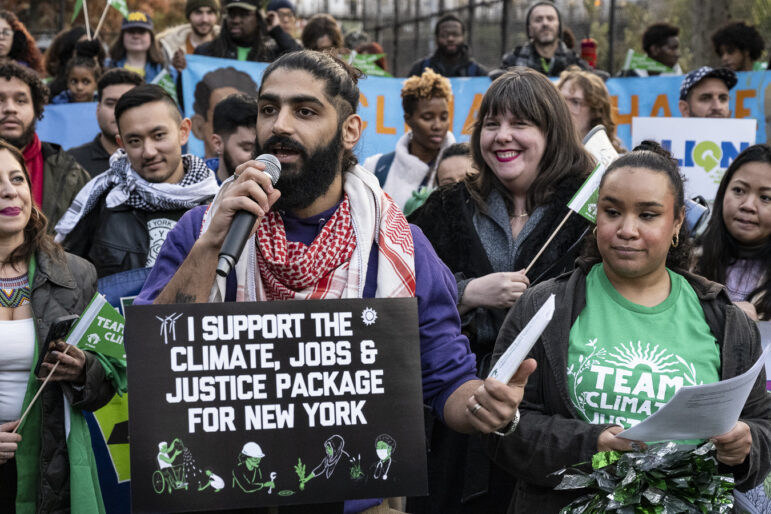Decking the BQE trench in the south side of Williamsburg is not just about turning concrete into greenery; it’s about mitigating the impacts of infrastructure that has long plagued our community.

Ken Schles
Advocates demand the Climate, Jobs and Justice Package for New York, which would support projects like BQGreen.The climate crisis is no longer an abstract concept but an urgent call for action. Tropical storms such as Ida and Ophelia have become a devastating annual occurrence. Wildfires across the continent have found their way to New York in the form of toxic orange skies. As we confront the unprecedented challenges posed by climate change, communities are stepping up to address these issues at the local level.
One grassroots initiative making waves in New York City is the BQGreen project, a transformative effort aimed at turning the Brooklyn-Queens Expressway (BQE) into an ecologically and socially productive space. The visionary project would entail the decking of the BQE trench section in order to offset the historic environmental harms. The project not only embodies the power of community-led solutions but also aligns with broader, statewide efforts to combat the climate crisis through centering environmental justice.
In the heart of the south side of Williamsburg, residents, facing the disproportionate impact of the climate crisis resulting in asthma rates twice the citywide average, have come together with other impacted communities to advocate for a sustainable future. They represent communities of more than 280,000 individuals who live alongside the BQE—a highway that carries nearly 150,000 vehicles every day. At the forefront of this movement is the BQE Environmental Justice Coalition (BQE-EJC), whose mission encompasses addressing environmental disparities and advocating for equitable solutions through envisioning a comprehensive, just solution for the BQE. This coalition, comprised largely of Black, Indigenous, and People of Color (BIPOC) community members, has tirelessly worked towards a reimagined BQE.
The BQGreen project is not merely a beautification effort; it’s a visionary undertaking with far-reaching implications. Capping two blocks of the BQE will not only provide recreational spaces, but will also mitigate environmental and public health hazards stemming from vehicular emissions. This project, nurtured over 15 years, encapsulates the resilience of a community determined to heal from historically divisive infrastructure. It is a testament to the power of community-driven design and its potential to transform overlooked spaces into sustainable urban landscapes.
While the BQGreen project is a local endeavor, it resonates beyond the south side of Williamsburg. The statewide climate and environmental justice coalition NY Renews, comprised of over 370 member organizations, has convened communities across the state to advocate for funding for grassroots initiatives like BQGreen via its People’s Climate Justice Budget (PCJB) demand in 2024. Along with the Climate, Jobs and Justice Package (CJJP), this statewide effort seeks not only to support the BQGreen project but other frontline community-led projects statewide, to secure essential financial resources to address the broader impacts of the climate crisis.
Nearly 5 years after passing New York’s climate law, the PCJB calls on the state to start laying the foundation necessary for addressing the climate crisis at scale. The PCJB outlines a $1 billion investment in projects designed by and for communities to be included in New York’s 2024 state budget, ensuring that the most effective and culturally sensitive solutions to the multifaceted challenges posed by climate change are supported. It highlights essential climate and environmental justice initiatives that would constitute a downpayment on the more than $10 billion annually required to address the crisis comprehensively.
Leveraging the 2023-established Climate Action Fund, New York has a historic opportunity to allocate billions to community-centric projects, identified as “shovel-ready” by NY Renews, promising consumer savings, rapid decarbonization, labor advancement, and an economically resilient and pollution-free future for the state.
Crucially, the BQGreen project is a BIPOC-led initiative addressing a community identified as a Disadvantaged Community (DAC). According to state guidelines, DACs are prioritized for funding, reflecting a commitment to rectifying historical environmental injustices. This underscores the imperative to support and uplift communities that have borne the brunt of ecological disparities, amplifying the urgency of approving the funds required for the BQGreen project.
The time to act is now. The People’s Climate Justice Budget presents a unique opportunity to channel one billion dollars into projects like the BQGreen, serving as proof of concept for the benefits of investing in our disadvantaged communities. Decking the BQE trench in the south side of Williamsburg is not just about turning concrete into greenery; it’s about mitigating the impacts of infrastructure that has long plagued our community. By investing in these community-visioned projects, we lay the foundation for a resilient and sustainable future, demonstrating that a community-led approach is not only effective but essential in the fight against the climate crisis.
Rami Dinnawi is the environmental justice campaign and policy manager for El Puente, a community human rights organization based in North Brooklyn and Puerto Rico.
Assemblymember Maritza Davila represents the communities of Bushwick & Williamsburg and champions the issues of education, healthcare, public safety, affordable housing, open space, and economic development.








